Page 4124 of 4264
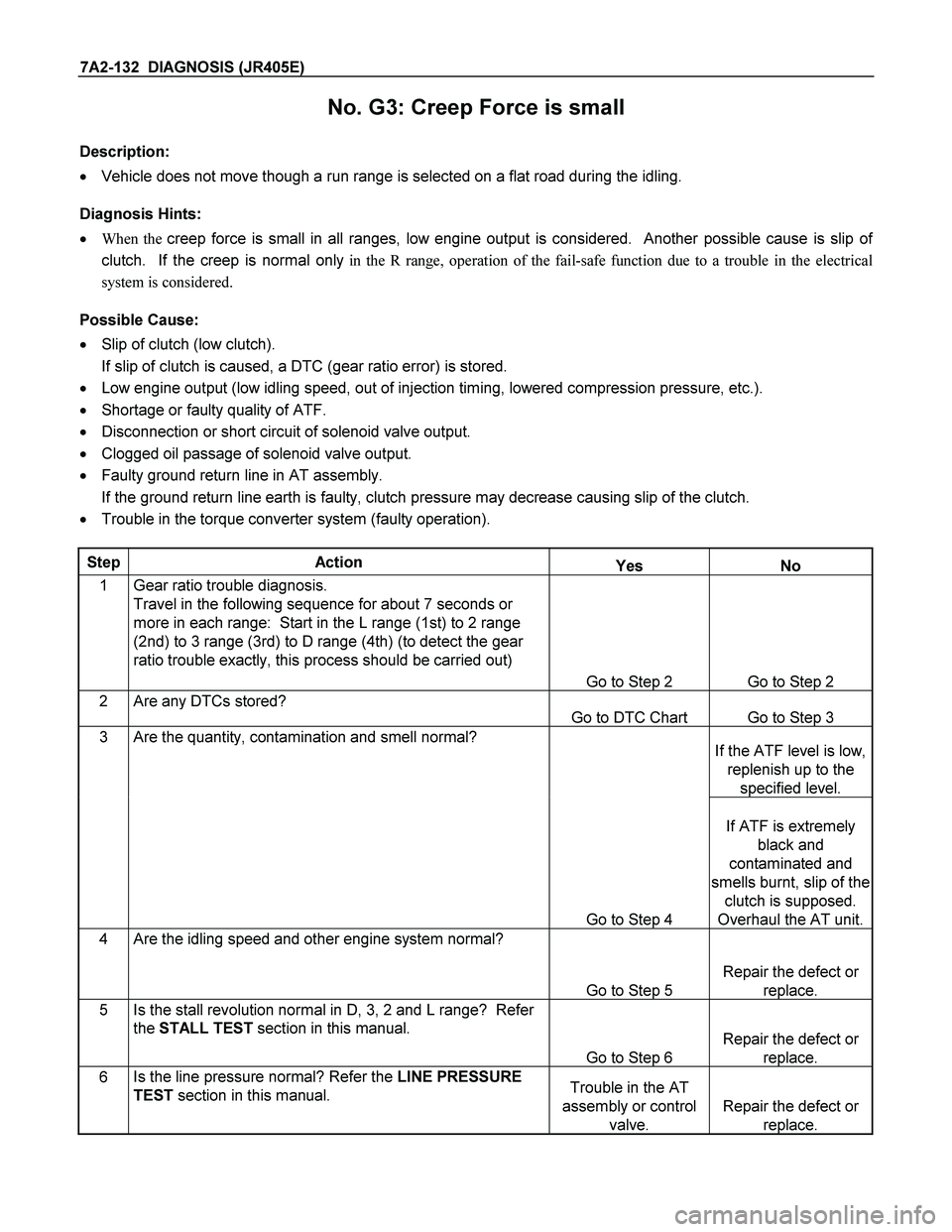
7A2-132 DIAGNOSIS (JR405E)
No. G3: Creep Force is small
Description:
� Vehicle does not move though a run range is selected on a flat road during the idling.
Diagnosis Hints:
� When the creep force is small in all ranges, low engine output is considered. Another possible cause is slip of
clutch. If the creep is normal only in the R range, operation of the fail-safe function due to a trouble in the electrical
system is considered.
Possible Cause:
� Slip of clutch (low clutch).
If slip of clutch is caused, a DTC (gear ratio error) is stored.
� Low engine output (low idling speed, out of injection timing, lowered compression pressure, etc.).
� Shortage or faulty quality of ATF.
� Disconnection or short circuit of solenoid valve output.
� Clogged oil passage of solenoid valve output.
� Faulty ground return line in AT assembly.
If the ground return line earth is faulty, clutch pressure may decrease causing slip of the clutch.
� Trouble in the torque converter system (faulty operation).
Step Action Yes No
1 Gear ratio trouble diagnosis.
Travel in the following sequence for about 7 seconds or
more in each range: Start in the L range (1st) to 2 range
(2nd) to 3 range (3rd) to D range (4th) (to detect the gear
ratio trouble exactly, this process should be carried out)
Go to Step 2 Go to Step 2
2 Are any DTCs stored?
Go to DTC Chart Go to Step 3
3 Are the quantity, contamination and smell normal? If the ATF level is low,
replenish up to the
specified level.
Go to Step 4
If ATF is extremely
black and
contaminated and
smells burnt, slip of the
clutch is supposed.
Overhaul the AT unit.
4 Are the idling speed and other engine system normal?
Go to Step 5
Repair the defect or
replace.
5 Is the stall revolution normal in D, 3, 2 and L range? Refer
the STALL TEST section in this manual.
Go to Step 6
Repair the defect or
replace.
6 Is the line pressure normal? Refer the LINE PRESSURE
TEST section in this manual. Trouble in the AT
assembly or control
valve.
Repair the defect or
replace.
Page 4125 of 4264
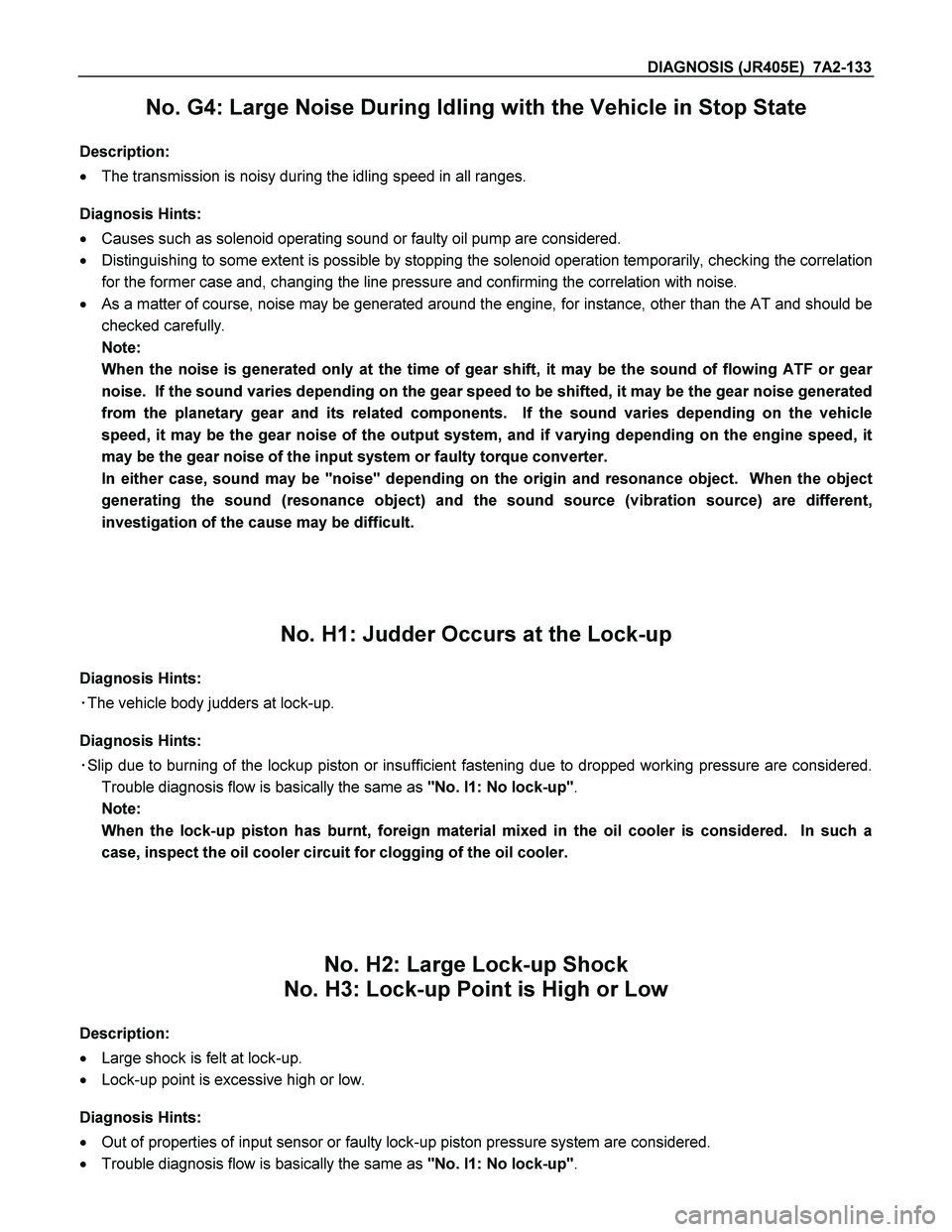
DIAGNOSIS (JR405E) 7A2-133
No. G4: Large Noise During Idling with the Vehicle in Stop State
Description:
� The transmission is noisy during the idling speed in all ranges.
Diagnosis Hints:
� Causes such as solenoid operating sound or faulty oil pump are considered.
� Distinguishing to some extent is possible by stopping the solenoid operation temporarily, checking the correlation
for the former case and, changing the line pressure and confirming the correlation with noise.
� As a matter of course, noise may be generated around the engine, for instance, other than the AT and should be
checked carefully.
Note:
When the noise is generated only at the time of gear shift, it may be the sound of flowing ATF or gear
noise. If the sound varies depending on the gear speed to be shifted, it may be the gear noise generated
from the planetary gear and its related components. If the sound varies depending on the vehicle
speed, it may be the gear noise of the output system, and if varying depending on the engine speed, it
may be the gear noise of the input system or faulty torque converter.
In either case, sound may be "noise" depending on the origin and resonance object. When the object
generating the sound (resonance object) and the sound source (vibration source) are different,
investigation of the cause may be difficult.
No. H1: Judder Occurs at the Lock-up
Diagnosis Hints:
�The vehicle body judders at lock-up.
Diagnosis Hints:
�Slip due to burning of the lockup piston or insufficient fastening due to dropped working pressure are considered.
Trouble diagnosis flow is basically the same as "No. I1: No lock-up".
Note:
When the lock-up piston has burnt, foreign material mixed in the oil cooler is considered. In such a
case, inspect the oil cooler circuit for clogging of the oil cooler.
No. H2: Large Lock-up Shock
No. H3: Lock-up Point is High or Low
Description:
� Large shock is felt at lock-up.
� Lock-up point is excessive high or low.
Diagnosis Hints:
� Out of properties of input sensor or faulty lock-up piston pressure system are considered.
� Trouble diagnosis flow is basically the same as "No. I1: No lock-up".
Page 4127 of 4264
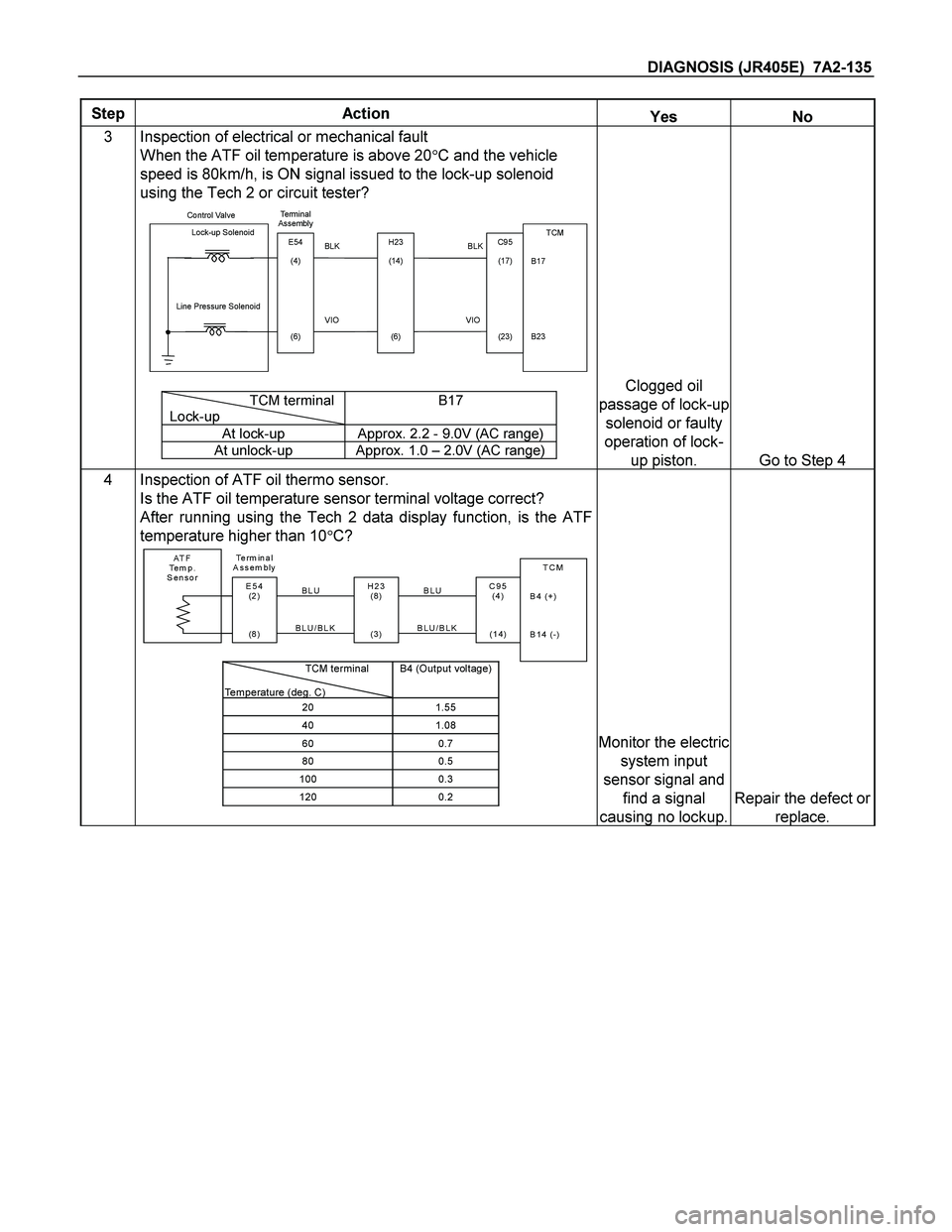
DIAGNOSIS (JR405E) 7A2-135
Step Action Yes No
3 Inspection of electrical or mechanical fault
When the ATF oil temperature is above 20�C and the vehicle
speed is 80km/h, is ON signal issued to the lock-up solenoid
using the Tech 2 or circuit tester?
Control Valve
TCM
B17
B23 BLK Lock-up Solenoid
Terminal
Assembly
VIO Line Pressure Solenoid
E54
(4)
(6)H23
(14)
(6)C95
(17)
(23) BLK
VIO
TCM terminal
Lock-upB17
At lock-up Approx. 2.2 - 9.0V (AC range)
At unlock-up Approx. 1.0 – 2.0V (AC range)
Clogged oil
passage of lock-up
solenoid or faulty
operation of lock-
up piston. Go to Step 4
4 Inspection of ATF oil thermo sensor.
Is the ATF oil temperature sensor terminal voltage correct?
After running using the Tech 2 data display function, is the ATF
temperature higher than 10�C?
AT F
Te m p .
SensorTCM
B4 (+)
B14 (-)
H23
(8)
(3)C95
(4)
(1 4) BLU Te r m in a l
Assembly
BLU/BLKE54
(2)
(8) BLU
BLU/BLK
TCM terminal
Temperature (deg. C)
B4 (Output voltage)
201.55
401.08
600.7
800.5
1000.3
1200.2
Monitor the electric
system input
sensor signal and
find a signal
causing no lockup.
Repair the defect or
replace.
Page 4128 of 4264
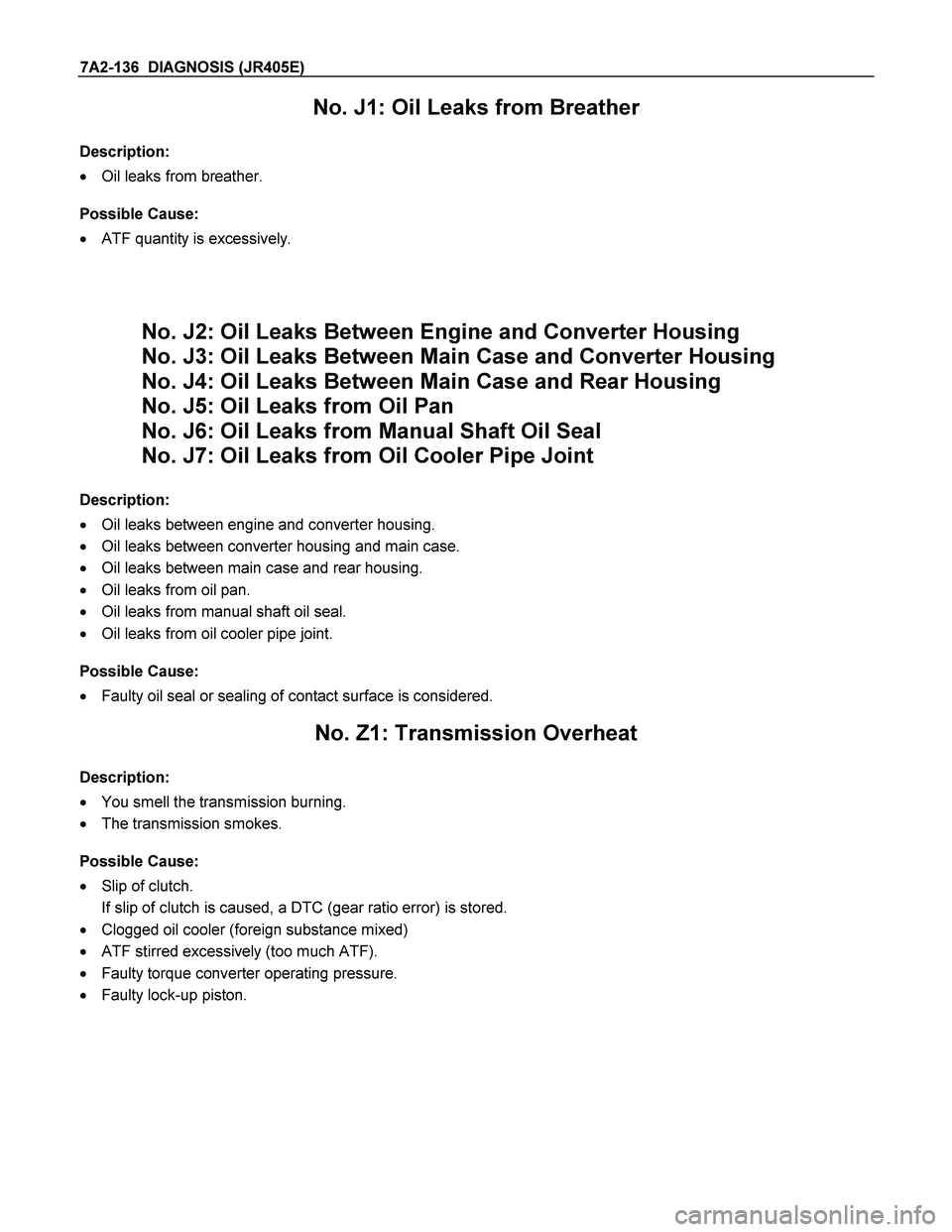
7A2-136 DIAGNOSIS (JR405E)
No. J1: Oil Leaks from Breather
Description:
� Oil leaks from breather.
Possible Cause:
� ATF quantity is excessively.
No. J2: Oil Leaks Between Engine and Converter Housing
No. J3: Oil Leaks Between Main Case and Converter Housing
No. J4: Oil Leaks Between Main Case and Rear Housing
No. J5: Oil Leaks from Oil Pan
No. J6: Oil Leaks from Manual Shaft Oil Seal
No. J7: Oil Leaks from Oil Cooler Pipe Joint
Description:
� Oil leaks between engine and converter housing.
� Oil leaks between converter housing and main case.
� Oil leaks between main case and rear housing.
� Oil leaks from oil pan.
� Oil leaks from manual shaft oil seal.
� Oil leaks from oil cooler pipe joint.
Possible Cause:
� Faulty oil seal or sealing of contact surface is considered.
No. Z1: Transmission Overheat
Description:
� You smell the transmission burning.
� The transmission smokes.
Possible Cause:
� Slip of clutch.
If slip of clutch is caused, a DTC (gear ratio error) is stored.
� Clogged oil cooler (foreign substance mixed)
� ATF stirred excessively (too much ATF).
� Faulty torque converter operating pressure.
� Faulty lock-up piston.
Page 4131 of 4264
DIAGNOSIS (JR405E) 7A2-139
No. Z11: Abnormal Oil Pressure
Description:
� Oil pressure is low or high.
Possible Cause:
� Basically, the same cause as "No. C1 - C8: Engine races up (slip) by shift up or shift down" is considered.
� In case of oil pressure is low, faulty oil pump is considered.
No. Z12: Reverse Buzzer Does Not Ring
Description:
� Reverse buzzer does not ring in R range.
Possible Cause:
� Disordered select cable.
� Disordered select lever.
� Disordered inhibitor switch.
Page 4132 of 4264
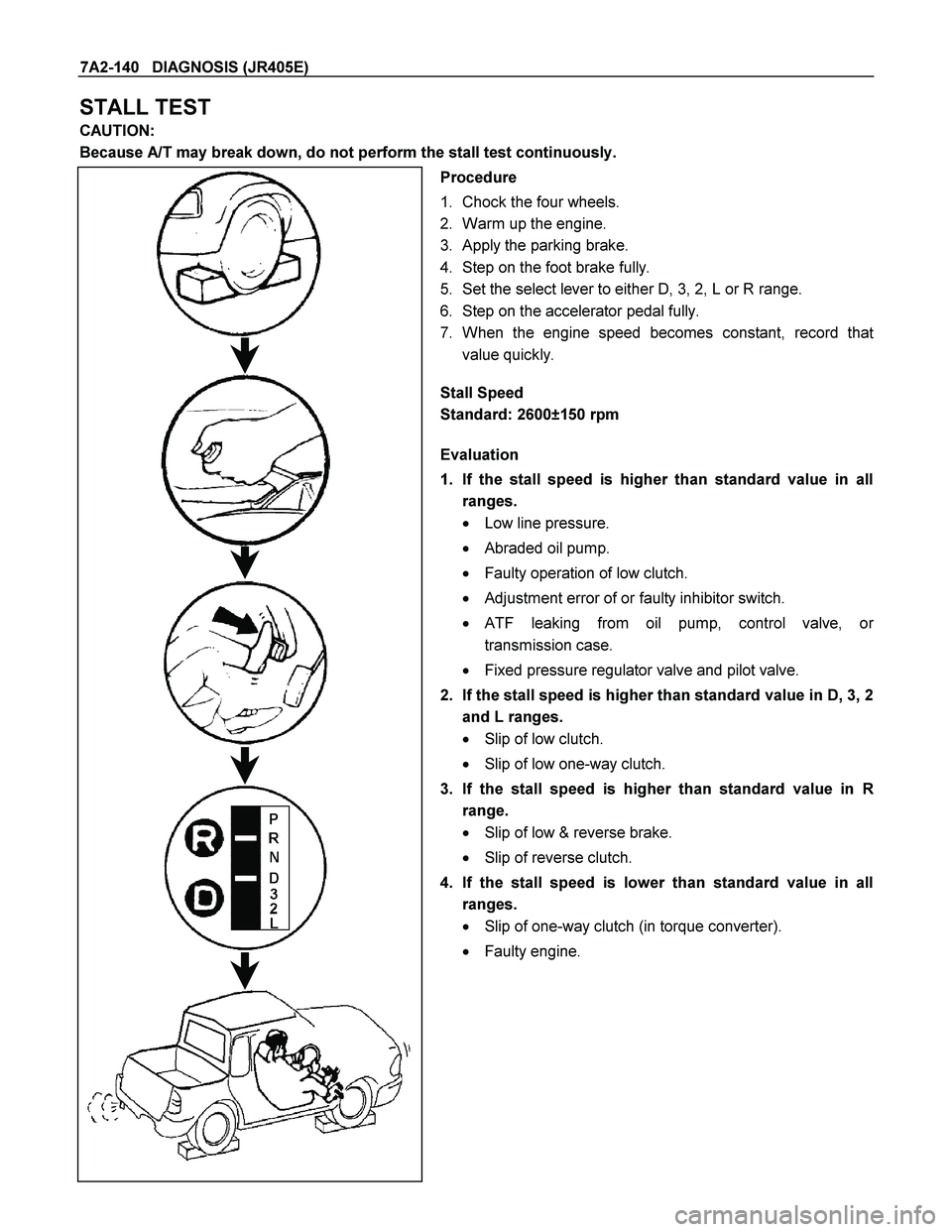
7A2-140 DIAGNOSIS (JR405E)
STALL TEST
CAUTION:
Because A/T may break down, do not perform the stall test continuously.
Procedure
1. Chock the four wheels.
2. Warm up the engine.
3. Apply the parking brake.
4. Step on the foot brake fully.
5. Set the select lever to either D, 3, 2, L or R range.
6. Step on the accelerator pedal fully.
7. When the engine speed becomes constant, record tha
t
value quickly.
Stall Speed
Standard: 2600±150 rpm
Evaluation
1. If the stall speed is higher than standard value in all
ranges.
� Low line pressure.
� Abraded oil pump.
� Faulty operation of low clutch.
� Adjustment error of or faulty inhibitor switch.
�
ATF leaking from oil pump, control valve, or
transmission case.
� Fixed pressure regulator valve and pilot valve.
2. If the stall speed is higher than standard value in D, 3, 2
and L ranges.
� Slip of low clutch.
� Slip of low one-way clutch.
3. If the stall speed is higher than standard value in
R
range.
� Slip of low & reverse brake.
� Slip of reverse clutch.
4. If the stall speed is lower than standard value in all
ranges.
� Slip of one-way clutch (in torque converter).
� Faulty engine.
Page 4133 of 4264
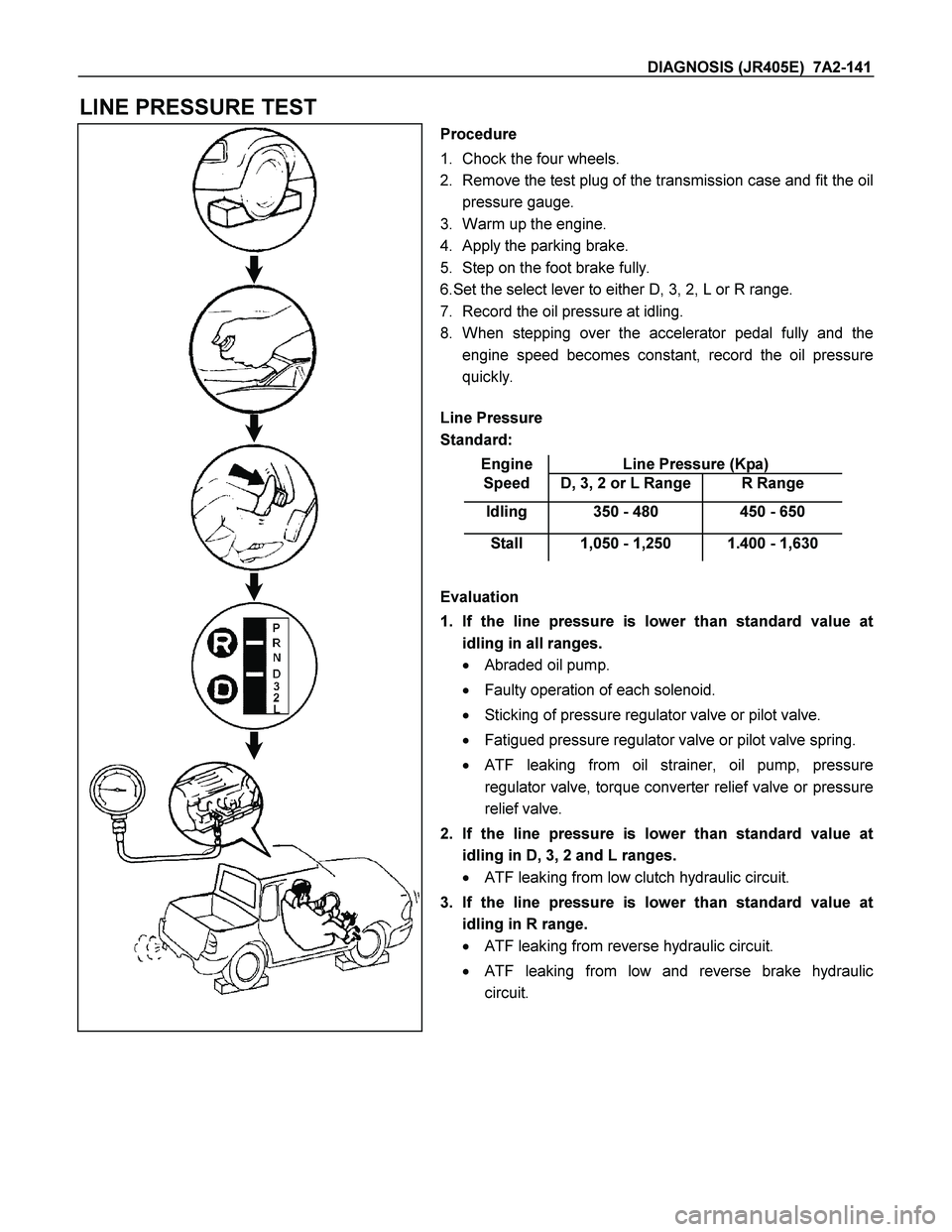
DIAGNOSIS (JR405E) 7A2-141
LINE PRESSURE TEST
Procedure
1. Chock the four wheels.
2. Remove the test plug of the transmission case and fit the oil
pressure gauge.
3. Warm up the engine.
4. Apply the parking brake.
5. Step on the foot brake fully.
6.Set the select lever to either D, 3, 2, L or R range.
7. Record the oil pressure at idling.
8. When stepping over the accelerator pedal fully and the
engine speed becomes constant, record the oil pressure
quickly.
Line Pressure
Standard:
Engine Line Pressure (Kpa)
Speed D, 3, 2 or L Range R Range
Idling 350 - 480 450 - 650
Stall 1,050 - 1,250 1.400 - 1,630
Evaluation
1. If the line pressure is lower than standard value at
idling in all ranges.
� Abraded oil pump.
� Faulty operation of each solenoid.
� Sticking of pressure regulator valve or pilot valve.
� Fatigued pressure regulator valve or pilot valve spring.
�
ATF leaking from oil strainer, oil pump, pressure
regulator valve, torque converter relief valve or pressure
relief valve.
2. If the line pressure is lower than standard value at
idling in D, 3, 2 and L ranges.
� ATF leaking from low clutch hydraulic circuit.
3. If the line pressure is lower than standard value at
idling in R range.
� ATF leaking from reverse hydraulic circuit.
� ATF leaking from low and reverse brake hydraulic
circuit.
Page 4134 of 4264
7A2-142 DIAGNOSIS (JR405E)
1. Oil Cooler Out
2. R Range Line Pressure Detection Port
(Low & Reverse Brake Pressure Detection Port)
3. D, 3, 2 & L Range Line Pressure Detection Port
(Low Clutch Pressure Detection Port)
4. Oil Cooler In
4. If the line pressure is lower than standard value at
idling in L and R ranges.
�
ATF leaking from low and reverse brake hydraulic
circuit.
5. If the line pressure is higher than standard value at
idling in all ranges.
� Throttle opening signal reception error.
� Faulty oil temperature sensor.
� Faulty operation of low clutch solenoid.
� Sticking pilot valve.
� Sticking pressure regulator valve or plug.
6. If the line pressure is lower than standard value at stall
speed in all ranges.
� Throttle opening signal reception error.
� Faulty operation of line pressure solenoid.
� Faulty operation of low clutch solenoid.
� Sticking pilot valve.
� Sticking pressure regulator valve or plug.